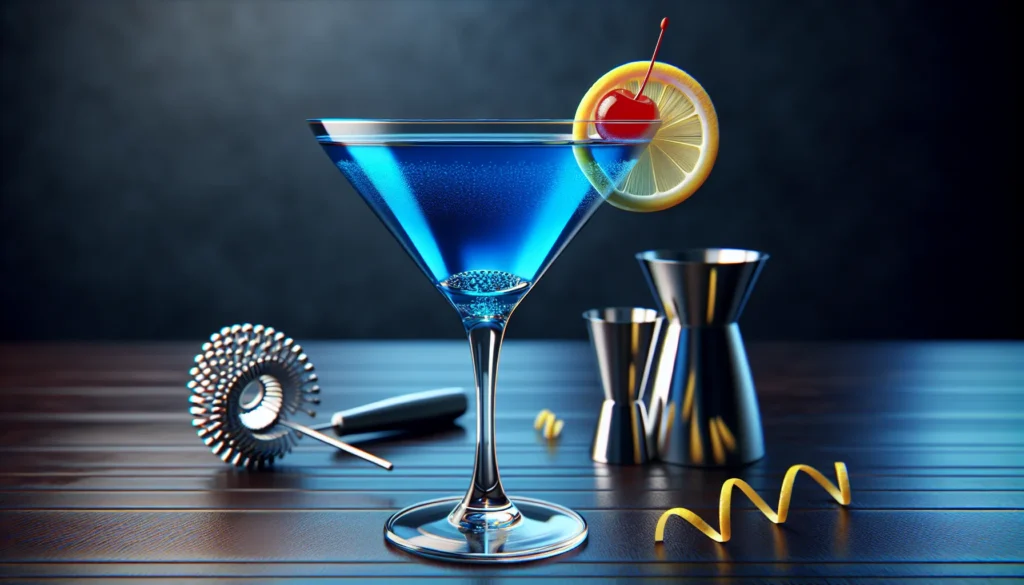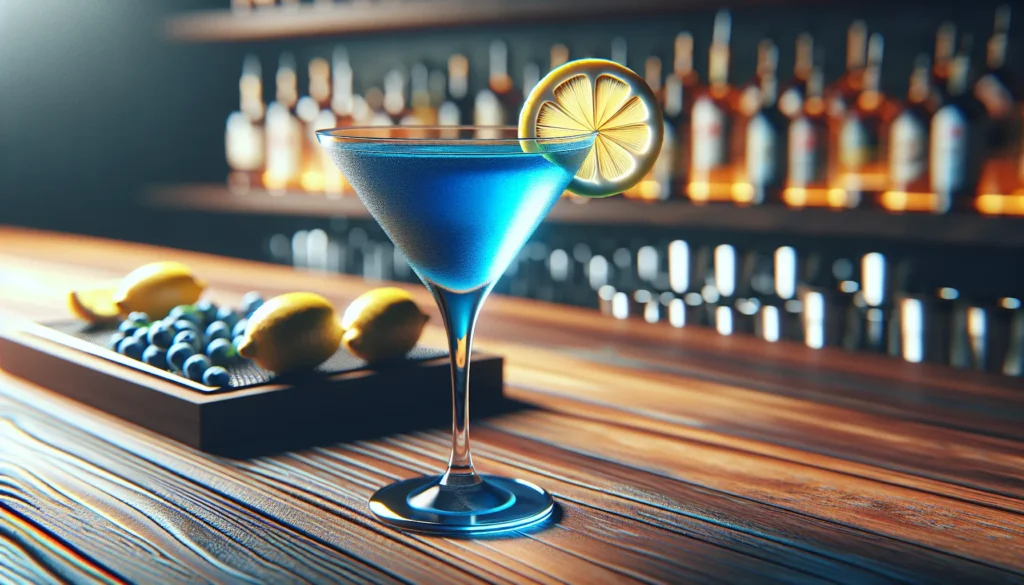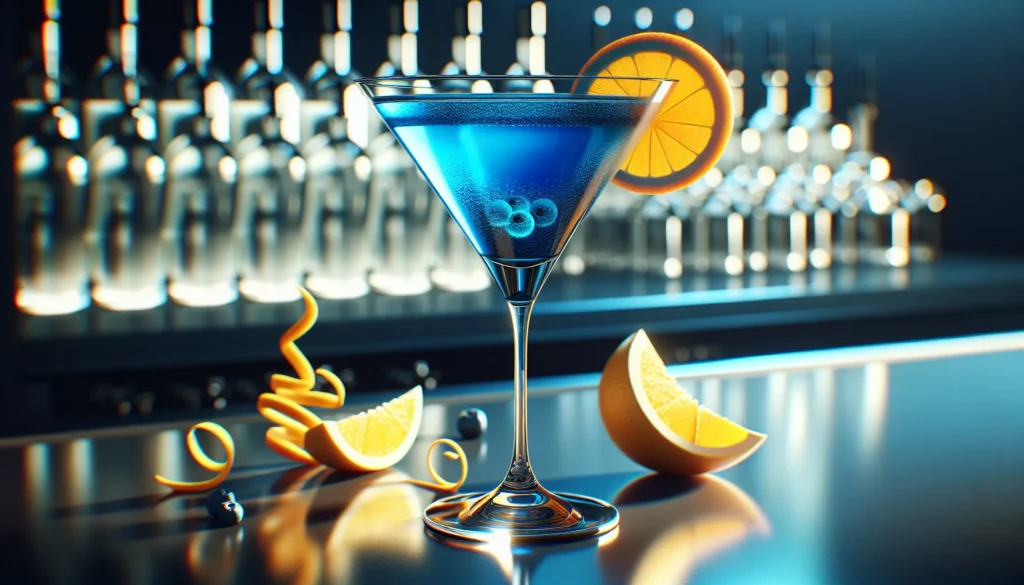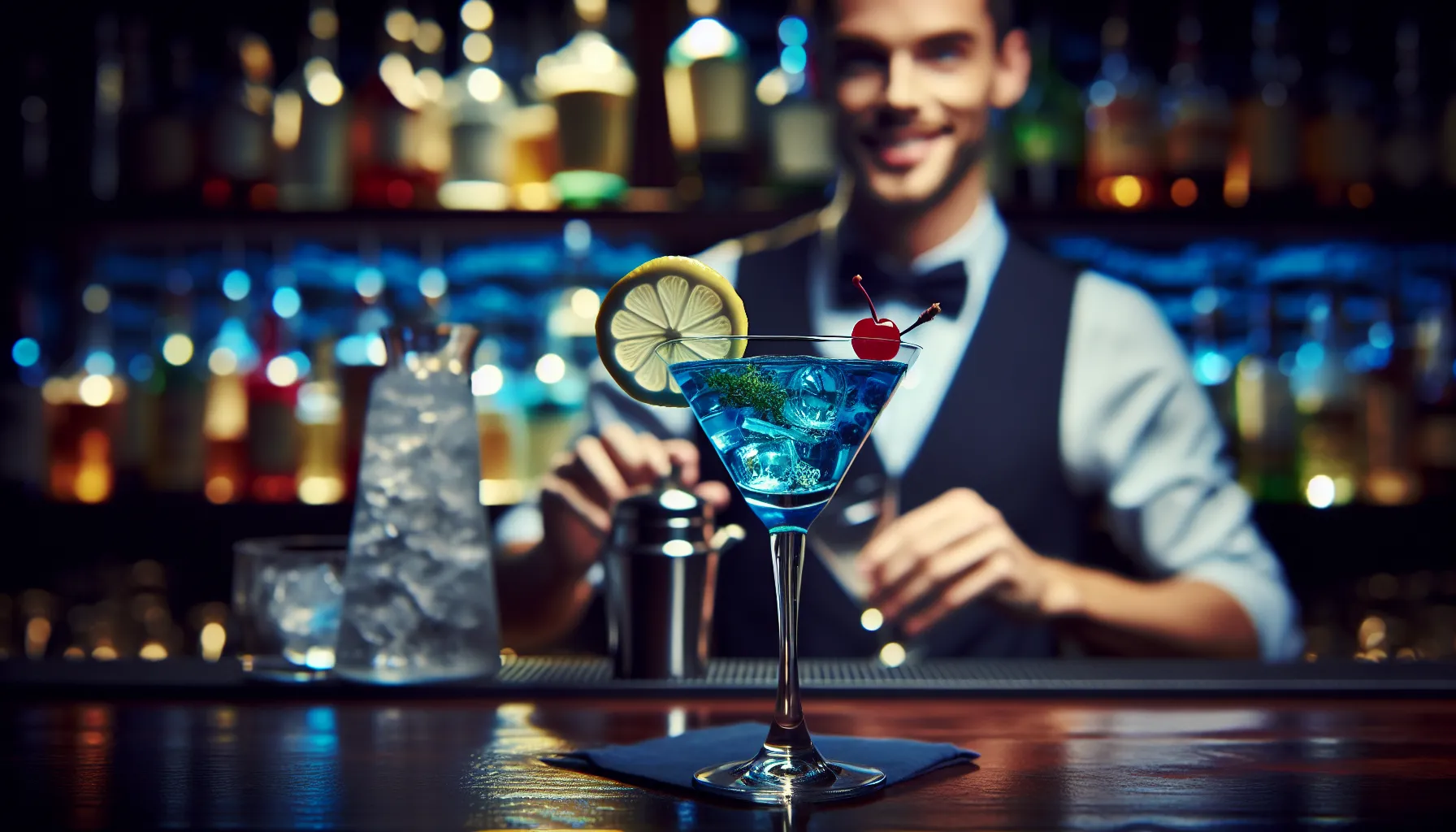Key Takeaways
- A blue martini is a vodka-based martini colored by blue curaçao, balanced with a touch of dry vermouth for a crisp, citrus-forward finish.
- Core recipe: 2 oz vodka, 0.5–1 oz blue curaçao, 0.25 oz dry vermouth; stir 20–30 seconds, fine strain into a chilled martini or coupe, garnish with a lemon twist.
- Quality matters: use clear ice, fresh vermouth (refrigerated, 30 days), and a reputable blue curaçao for vivid color, clean aroma, and proper dilution (15–20%).
- Easy variations: swap vodka for London Dry gin, add orange bitters for complexity, or introduce a light sour tilt with 0.25 oz lemon juice and simple syrup.
- Batch-friendly: pre-dilute with 20% cold water by total spirits volume, chill the pitcher and glassware, and garnish each pour to serve consistently.
- Order like a pro: ask for a “blue martini, stirred, up, lemon twist—no sour mix” to avoid Blue Lagoon-style builds and keep the drink clear and spirit-forward.
I still remember the first time I saw a blue martini. It glowed like neon in a low lit lounge. I thought it was all flash. Then one sip changed my mind. The citrus snap met a silky finish. It felt like a summer night in a glass.
In this quick guide I share what makes this cocktail pop and how to order or mix it with confidence. We will touch on its ocean hue the bright orange liqueur that paints it and simple twists that keep it fresh. I will keep it easy and fun so you can shake one at home or pick a great one at the bar.
What Is A Blue Martini?
A blue martini is a spirit‑forward martini riff colored by blue curaçao and built on vodka. I mix vodka with blue curaçao, then I balance with dry vermouth. I serve it up in a chilled coupe or V‑glass. I aim for ocean blue color, bright citrus aroma, and a clean finish. I base this on established specs and ingredient standards from Difford’s Guide, Liquor.com, and brand references for curaçao [Difford’s Guide], [Liquor.com], [Bols].
- Ingredients: vodka, blue curaçao, dry vermouth, citrus garnish
- Flavor: orange oil, bitter orange peel, light vanilla, neutral grain
- Color: electric blue, high clarity, reflective surface
- Method: stir with ice, fine strain, express lemon twist
- Glassware: stemmed martini glass, chilled rim, no ice
- Occasion: pre‑dinner aperitif, lounge service, late‑night order
Typical build and metrics
| Item | Amount | Notes |
|---|---|---|
| Vodka | 2.0 oz | 40% ABV base spirit [Liquor.com] |
| Blue curaçao | 0.5 oz | Orange liqueur, dyed blue, ~20–25% ABV [Bols] |
| Dry vermouth | 0.25 oz | Fortified wine, ~15–18% ABV |
| Stir time | 20–30 s | Standard dilution for spirit‑only builds |
| In‑glass ABV | ~26–28% | Estimate after dilution, based on the above |
| Calories | ~180–200 kcal | Estimate for one 3–3.5 oz serving |
What makes the blue martini blue
- Dye: FD&C Blue No. 1 in blue curaçao provides the hue [Bols]
- Base: curaçao style liqueur uses bitter orange peels from Laraha, then sweetening [EU Reg. 110/2008, via CEN/SpiritsEUROPE]
- Balance: vodka lengthens citrus notes without adding botanicals
Common variations I use
- Gin swap: London dry gin for vodka, more juniper, more spice [Difford’s Guide]
- Sour tilt: fresh lemon juice 0.25 oz, simple syrup 0.25 oz, lighter ABV, brighter acid [Liquor.com]
- Orange bitters: 1–2 dashes, more peel complexity, less sweetness
Ingredient facts at a glance
- Vodka: neutral spirit at ≥37.5% ABV in the EU, typically 40% in the US [TTB]
- Blue curaçao: flavored orange liqueur category, color derived from permitted dyes, ABV ranges by brand [Bols]
- Dry vermouth: aromatized wine with wormwood, sugar capped at low levels, ~15–18% ABV [EU Reg. 251/2014]
References: Difford’s Guide, Blue Martini recipes and methods; Liquor.com, Blue Martini overview and specs; Bols, Blue Curaçao product data and coloring details; TTB Beverage Alcohol Manual for vodka standards; EU spirits and aromatized wine regulations for category definitions.
Ingredients And Tools

I keep the blue martini simple and exact. I match clean spirits with bright citrus to lock in color and balance.
Core Ingredients
Core ingredients define the blue martini’s color and flavor.
| Ingredient | Measure | Purpose |
|---|---|---|
| Vodka | 2 oz | Neutral base, crisp finish |
| Blue curaçao | 1 oz | Orange citrus, electric hue |
| Dry vermouth | 0.25 oz | Herbal lift, dry edge |
- Vodka delivers a 40% ABV base for structure, source: Alcohol and Tobacco Tax and Trade Bureau.
- Blue curaçao supplies orange liqueur notes at 20–30% ABV, source: European Commission Spirit Drinks Regulation.
- Dry vermouth contributes aromatized wine at 15–18% ABV, source: EU Regulation No 251/2014.
Optional Add-Ins And Garnishes
Optional add-ins and garnishes tailor a blue martini to taste.
- Lemon bitters intensify citrus, examples include Fee Brothers and Regans’ No 6.
- Orange bitters deepen peel notes, examples include Angostura and Scrappy’s.
- Fresh lemon juice brightens acidity at 0.25 oz, examples include Eureka and Lisbon.
- Simple syrup softens edges at 0.25 oz, examples include 1:1 and demerara.
- Lemon twist adds oils for aroma, examples include wide peels and tight curls.
- Orange peel amplifies curaçao, examples include navel and Valencia.
- Brandied cherry adds color contrast, examples include Luxardo and Amarena.
- Sea salt pinch heightens sweetness, examples include flaky and fine, if the curaçao tastes bitter.
Bar Tools You’ll Need
Bar tools keep the blue martini cold and clear.
- Mixing glass chills and dilutes with control.
- Jigger measures exact 0.25 oz, 0.5 oz, 1 oz, and 2 oz pours.
- Bar spoon stirs smoothly for 20–30 seconds, if the ice feels dense.
- Hawthorne strainer holds back cubes on the pour.
- Fine strainer catches chips for a glassy surface.
- Citrus peeler makes a tight twist for expressed oils.
- Coupe or martini glass presents the blue martini with a wide rim.
How To Make A Blue Martini

I keep this blue martini process fast and precise. I balance chill, dilution, and color for a clean sip.
Classic Recipe (Step-By-Step)
- Chill: Freeze the martini glass for 10 minutes.
- Measure: Use a jigger for exact pours.
- Combine: Add 2 oz vodka, 1 oz blue curaçao, 0.25 oz dry vermouth to a mixing glass.
- Fill: Add fresh ice to the top.
- Stir: Stir 20 to 25 seconds for proper chill and dilution.
- Strain: Strain into the chilled glass.
- Garnish: Express a lemon twist over the surface, then drop or discard.
- Serve: Present the blue martini ice cold.
Numbers at a glance
| Item | Amount |
|---|---|
| Vodka | 2 oz |
| Blue curaçao | 1 oz |
| Dry vermouth | 0.25 oz |
| Stir time | 20–25 seconds |
| Yield | 1 cocktail |
Notes and tweaks
- Swap: Use an orange twist for a sweeter aroma if you want round citrus.
- Boost: Add 1 dash orange bitters for extra depth if you like a drier finish.
- Brighten: Add 0.25 oz fresh lemon juice for tang if you enjoy a sour edge.
- Sweeten: Add 0.25 oz simple syrup for balance if your curaçao tastes bitter.
Dilution reference
- Expect: About 20 percent dilution from proper stirring if you use standard cube ice. [Source: Dave Arnold, Liquid Intelligence, 2014]
- Target: Final volume lands near 3.9 oz including dilution if you follow the ratio.
Batch And Pitcher Instructions
I scale the same blue martini spec for clean batching.
- Choose: Use a 1 qt pitcher for up to 8 servings.
- Pre chill: Chill the pitcher and the serving glasses for 15 minutes.
- Mix: Combine spirits in the pitcher without ice.
- Add water: Add cold filtered water to pre dilute.
- Store: Cover and refrigerate until service.
- Pour: Stir in the pitcher, then pour into chilled glasses.
- Garnish: Add fresh lemon twists to each blue martini.
Batch ratios
| Servings | Vodka | Blue curaçao | Dry vermouth | Cold water add | Final yield |
|---|---|---|---|---|---|
| 2 | 4 oz | 2 oz | 0.5 oz | 1.3 oz | ~7.8 oz |
| 4 | 8 oz | 4 oz | 1 oz | 2.6 oz | ~15.6 oz |
| 8 | 16 oz | 8 oz | 2 oz | 5.2 oz | ~31.2 oz |
- Calculate: Use 20 percent water by total spirits volume if you pre dilute. [Source: Dave Arnold, Liquid Intelligence, 2014]
- Serve: Keep the pitcher on ice for service if the room runs warm.
- Adjust: Cut water by 10 percent for pebble ice service if you expect extra melt.
Flavor Variations And Twists

Flavor variations expand the blue martini without losing its core. Twists keep the color, the chill, and the clean finish.
Vodka Vs. Gin Blue Martini
Vodka vs gin changes the blue martini’s structure and aroma. Vodka keeps the drink crisp and orange forward, gin adds juniper and herbs.
- Choose vodka for a neutral base if you want citrus to lead
- Choose London Dry gin for juniper and coriander if you want botanicals to speak
- Choose citrus gin for a brighter nose if you want amplified orange notes
- Choose a lemon twist garnish for vodka if you want a clean lift
- Choose an orange peel garnish for gin if you want unity with curaçao
Key differences and ratios:
| Build | Spirit | Ratio | Flavor notes | Source |
|---|---|---|---|---|
| Vodka blue martini | 2 oz vodka, 1 oz blue curaçao, 0.25 oz dry vermouth | 8:4:1 | Clean base, orange citrus, light herbal finish | Difford’s Guide, Vodka flavor neutrality overview |
| Gin blue martini | 2 oz London Dry gin, 1 oz blue curaçao, 0.25 oz dry vermouth | 8:4:1 | Juniper pine, orange peel, herbal complexity | EU Reg 2019/787, gin juniper predominance |
I keep stir time at 20 to 30 seconds if the spirit is overproof. I increase dilution to 25 percent pre-dilution in batched gin builds if the gin leans high in botanicals.
References:
- Difford’s Guide, Vodka, flavor profile and production
- European Regulation 2019/787, gin defined by juniper predominance
Tropical And Dessert Spins
Tropical and dessert spins push the blue martini toward fruit and confection. I keep the base blue curaçao, then layer one modifier.
- Build short for rich dessert notes if the add-in is sugary
- Build tall for tropical freshness if the add-in is acidic
- Stir for clarity if no juice enters the mix
- Shake for texture if citrus or cream enters the mix
Recipe matrix:
| Variation | Base | Modifiers | Measures | Method | Profile |
|---|---|---|---|---|---|
| Blue coconut martini | 2 oz vodka | 0.5 oz blue curaçao, 0.5 oz coconut liqueur, 0.25 oz dry vermouth | 2, 0.5, 0.5, 0.25 oz | Stir, strain, lime wheel | Coconut cream, orange, crisp finish |
| Blue pineapple sour | 1.75 oz vodka | 0.75 oz blue curaçao, 0.75 oz pineapple juice, 0.25 oz lemon juice, 0.25 oz simple syrup | 1.75, 0.75, 0.75, 0.25, 0.25 oz | Shake, strain, pineapple leaf | Tropical tang, soft sweetness |
| Blue passion fruit | 2 oz gin | 0.5 oz blue curaçao, 0.5 oz passion fruit liqueur, 2 dashes orange bitters | 2, 0.5, 0.5 oz, 2 dashes | Stir, strain, grapefruit peel | Tart passion fruit, botanical lift |
| Blue vanilla cream | 1.5 oz vodka | 0.5 oz blue curaçao, 0.5 oz vanilla liqueur, 0.5 oz half and half | 1.5, 0.5, 0.5, 0.5 oz | Shake, strain, orange zest | Dessert cream, orange pop |
| Blue white chocolate | 1.5 oz vodka | 0.5 oz blue curaçao, 0.75 oz white crème de cacao | 1.5, 0.5, 0.75 oz | Stir hard, strain, cherry | Cocoa silk, citrus accent |
I keep blue curaçao as the color anchor if other liqueurs enter the glass. I switch to clear curaçao at 0.5 oz plus 1 drop blue food color if the blue curaçao reads too sweet.
- IBA, Curaçao, orange peel liqueur background
- Difford’s Guide, Blue curaçao, production and flavor notes
Pro Tips, Pairings, And Presentation
I keep the blue martini crisp, vivid, and balanced. I use small moves that make big differences in the glass.
Expert Tips For Color And Clarity
Color and clarity stay sharp with cold tools, clear ice, and gentle technique. I stir, not shake, to lock in transparency and a tight texture, then I fine strain if I add juice.
- Use clear ice, large cubes, and a clean mixing glass for a bright blue tone.
- Use vodka from a fresh bottle to avoid oxidation notes and clouding.
- Use high-quality blue curaçao with E133 for saturated color and clean orange aroma.
- Stir 20–30 seconds over solid ice for controlled chill and dilution.
- Keep citrus minimal or fine strain to reduce haze from pulp and oils.
- Keep the glass frozen 15 minutes for a dry, frost-free surface.
- Keep modifiers clear, like dry vermouth and bitters, for a jewel-like finish.
- Express a lemon twist over the surface, not in the drink, if I want zero haze.
Key service targets
| Metric | Target |
|---|---|
| Stir time | 20–30 seconds |
| Dilution | 15–20% by volume |
| Serving temp | -5 to -1 °C |
| Final ABV | 24–28% |
References: Difford’s Guide on stirring and dilution (https://www.diffordsguide.com/encyclopedia/1371/terms/stirring-cocktails), Serious Eats on stirred cocktail technique (https://www.seriouseats.com/stirred-cocktails-stirring-technique)
Food Pairings And Occasions
Food pairings lean salty, briny, and crisp to match citrus and ethanol lift. I favor light, high-impact bites that echo the orange notes in blue curaçao.
- Pair oysters on the half shell, shrimp cocktail, and scallop crudo for clean salinity.
- Pair sushi nigiri, hamachi with yuzu, and salmon roe for umami and pop.
- Pair fried calamari, coconut shrimp, and tempura vegetables for texture contrast.
- Pair goat cheese crostini, manchego wedges, and marcona almonds for fat balance.
- Pair citrus desserts, like lemon tart and orange shortbread, for a sweet finish.
Occasions land best where color and sparkle matter. I pour blue martinis for these setups.
- Host beach parties, pool gatherings, and summer cookouts.
- Host neon nights, birthday toasts, and themed 80s playlists.
- Host cocktail hours, gallery openings, and date-night aperitif rounds.
Glassware And Garnish Ideas
Glassware and garnishes frame the electric blue and guide aroma. I pick shapes that spotlight color and reduce spills.
- Choose a Nick and Nora for compact elegance and slower warm-up.
- Choose a classic V martini glass for a dramatic surface and color display.
- Choose a small coupe for stability if service moves around a room.
- Choose clear crystal for maximum saturation and sparkle.
- Garnish a wide lemon twist, 1×3 in, for bright citrus oils.
- Garnish an orange peel coin for curaçao echo and sweet zest.
- Garnish a dehydrated orange wheel for zero dilution and clean lines.
- Garnish a brandied cherry on a short pick for a visual anchor.
- Garnish a blue cornflower petal pinch for a color match without flavor shift.
- Garnish a rim micro-salt, sugar, and citric acid 2:2:0.25 for a tart sparkle.
Common Mistakes To Avoid
Common mistakes ruin a blue martini when basics slip.
- Measure precisely. I use 2 oz vodka, 1 oz blue curaçao, 0.25 oz dry vermouth, I level each pour with a jigger.
- Stir, not shake. I stir to keep clarity and texture for a spirit forward drink, IBA and Difford’s Guide back this method.
- Chill fully. I freeze the glass, I use cold spirits and cold tools to slow melt and keep that electric blue.
- Choose quality curaçao. I pick an orange liqueur with real citrus oils, I avoid neon syrups and off flavors, Difford’s Guide notes big brand variance.
- Protect vermouth. I refrigerate after opening, I finish the bottle in 30 days for bright herbal notes, WSET and producers advise this timeline.
- Use hard clear ice. I avoid small wet cubes and crushed ice that over dilute, I prefer large clear cubes for slow melt, Arnold 2014 documents dilution control.
- Control curaçao sweetness. I keep curaçao at 1 oz, I add only 0.25 oz lemon or 0.25 oz simple if I want balance, I taste before changing ratios.
- Match the garnish. I pick a lemon twist or an orange wheel for citrus lift, I skip juicy cherries that bleed and gray the blue.
- Fix batch dilution. I add cold water to hit service dilution, I scale 20% water by total alcohol volume for a clean blue martini in a pitcher.
- Specify at bars. I order a blue martini stirred up with a lemon twist and no sour mix, I avoid getting a Blue Lagoon build.
Key blue martini targets
| Metric | Target | Context | Source |
|---|---|---|---|
| Stir time | 25–35 seconds | Mixing glass with solid ice | IBA, Difford’s Guide |
| Dilution | 18–22% by volume | Spirit forward builds | Arnold, Liquid Intelligence |
| Service temp | 28–30°F, -2 to -1°C | Up, chilled glass | Arnold, lab tests |
| Vermouth freshness | 30 days after opening | Refrigerated bottle | WSET, producers |
| Batch water | 20% of total alcohol volume | Pre dilution for pitchers | Arnold, bar practice |
- IBA, Official cocktails, method guidance
- Difford’s Guide, stirring standards, curaçao quality notes
- WSET, fortified wine storage and freshness
- Dave Arnold, Liquid Intelligence, dilution and temperature science
Conclusion
I hope this blue beauty sparks your curiosity and your creativity. Let it be your canvas and trust your palate. If it brings a smile then you nailed it.
Share your favorite riff with me. Snap a pic and tag me so I can cheer you on. If you want more bright sips and easy wins hit that follow and stick around.
Your next standout pour is only a chilled glass away. Raise a glass to bold color brave choices and good company. Cheers
Frequently Asked Questions
What is a blue martini?
A blue martini is a spirit-forward cocktail made with vodka, blue curaçao, and dry vermouth. It’s stirred, served up in a chilled martini glass, and known for its electric blue color, citrus aroma, and clean, crisp finish.
What are the core ingredients and measurements?
Use 2 oz vodka, 1 oz blue curaçao, and 0.25 oz dry vermouth. Optional: 1–2 dashes lemon or orange bitters, a barspoon simple syrup, or a squeeze of fresh lemon to tweak sweetness and acidity. Garnish with a lemon twist, orange peel, or a brandied cherry.
What gives the blue martini its color?
Blue curaçao. It’s an orange liqueur colored bright blue, which delivers both the hue and citrus notes. Keep blue curaçao as the color anchor, even when exploring variations or adding other modifiers.
How do I make a blue martini at home?
Chill your glass. Add vodka, blue curaçao, and dry vermouth to a mixing glass with ice. Stir 20–30 seconds until very cold and slightly diluted. Strain into the chilled glass. Garnish with a lemon twist or orange peel. Serve immediately.
Should I stir or shake a blue martini?
Stir. Stirring preserves clarity and a silky texture while delivering controlled dilution. Shaking can cloud the drink, mute the electric color, and over-dilute the cocktail.
What tools do I need?
A mixing glass, jigger, bar spoon, strainer, and a chilled martini or Nick & Nora glass. Clear, cold ice improves clarity and temperature. A peeler or channel knife helps with clean citrus garnishes.
Can I use gin instead of vodka?
Yes. Gin creates a more aromatic, structured blue martini. Try 2 oz gin, 1 oz blue curaçao, 0.25 oz dry vermouth. Garnish with a lemon twist to highlight botanicals. Vodka offers a cleaner, more neutral base.
How do I adjust sweetness and acidity?
For sweeter: add 0.25 oz simple syrup or use a richer curaçao. For brighter: add 0.25–0.5 oz fresh lemon juice or 1–2 dashes citrus bitters. Taste and adjust in tiny increments to keep balance and color.
What are popular variations?
Tropical: add coconut, pineapple, or passion fruit for a refresher. Dessert-style: vanilla, white chocolate, or cream for richness. Keep blue curaçao in place, and layer modifiers lightly so the drink stays clear and vibrant.
How do I batch a blue martini for a party?
For 8 servings: 16 oz vodka, 8 oz blue curaçao, 2 oz dry vermouth, plus 4–5 oz cold water for pre-dilution. Stir in a pitcher over ice or pre-chill the mix. Store cold and pour into chilled glasses. Garnish to order.
What’s the ideal dilution, temperature, and ABV?
Aim for 20–25% dilution, serving at about 28–32°F (-2 to 0°C). Final ABV typically lands around 22–24%, depending on your ingredients and dilution level.
Which glassware and garnishes work best?
Use a chilled martini or Nick & Nora glass to showcase the color. Garnish with a lemon twist, dehydrated orange wheel, or a brandied cherry. Keep garnishes minimal to avoid muddying the hue.
What common mistakes should I avoid?
- Eyeballing measurements
- Shaking instead of stirring
- Warm glassware or tools
- Stale vermouth (older than 1–2 months opened)
- Poor-quality or cloudy ice
- Over-garnishing that affects flavor or color
How should I store vermouth and curaçao?
Refrigerate opened dry vermouth and use within 1–2 months for freshness. Blue curaçao is shelf-stable; keep it cool and away from light. Always re-check aromas before mixing.
What food pairs well with a blue martini?
Briny and citrus-friendly bites shine: oysters, sushi, shrimp cocktail, ceviche, lemony olives, and light citrus desserts. Avoid heavy, creamy dishes that can overshadow the cocktail’s crisp citrus profile.
Any tips for ordering a blue martini at a bar?
Ask for it stirred, up, with precise specs: “Vodka blue martini—2 oz vodka, 1 oz blue curaçao, 0.25 oz dry vermouth, stirred and served up, lemon twist.” Request a chilled glass and clear garnish to preserve clarity.

